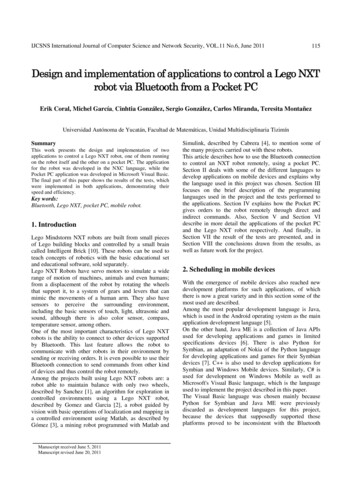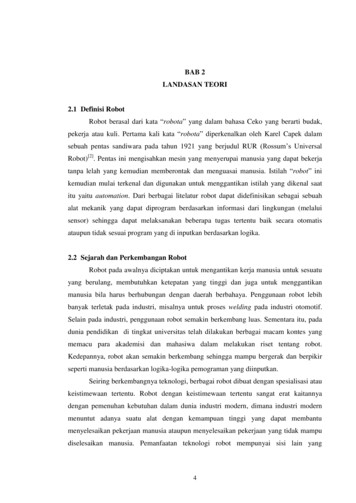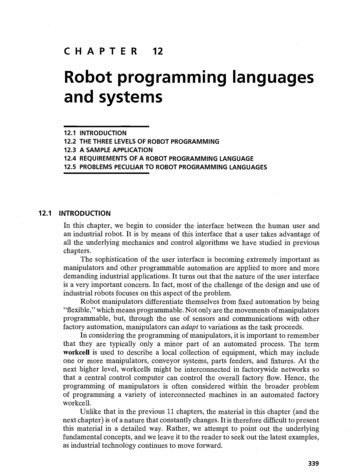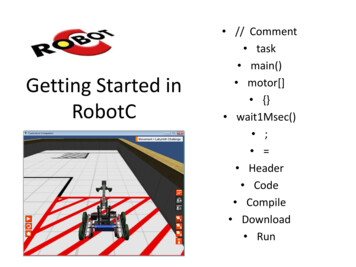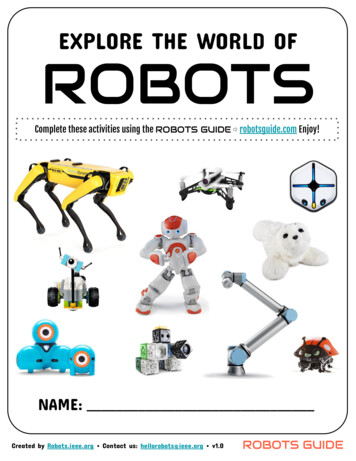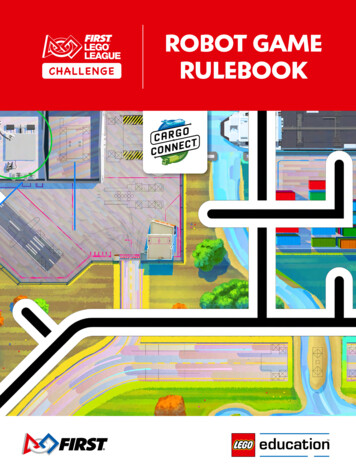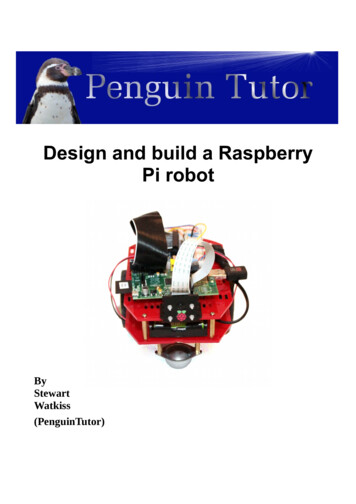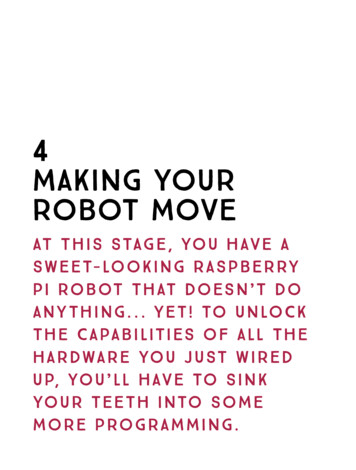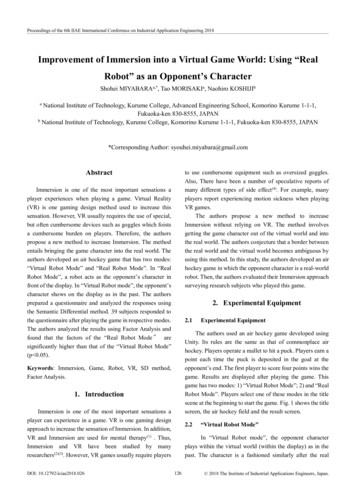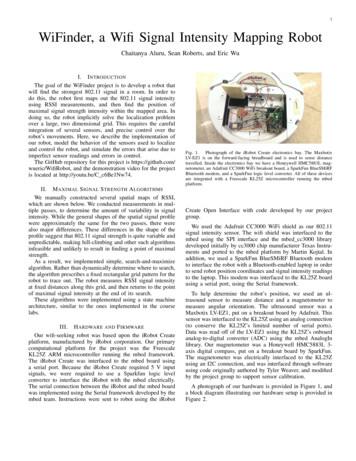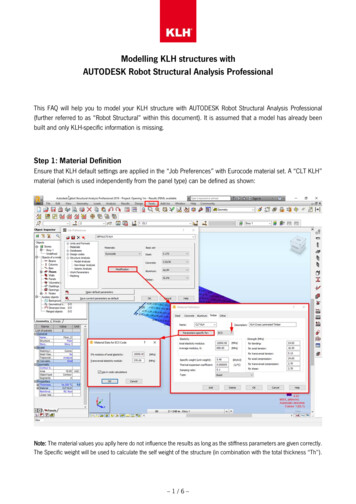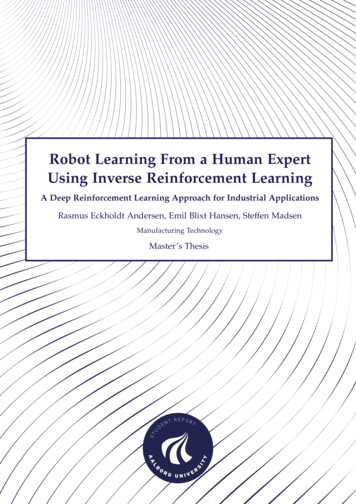
Transcription
Robot Learning From a Human ExpertUsing Inverse Reinforcement LearningA Deep Reinforcement Learning Approach for Industrial ApplicationsRasmus Eckholdt Andersen, Emil Blixt Hansen, Steffen MadsenManufacturing TechnologyMaster’s ThesisSTUDENT REPORT
Copyright c Aalborg University 2019
Department of Materials and ProductionAalborg Universityhttp://www.aau.dkTitle:Robot Learning From a Human ExpertUsing Inverse Reinforcement LearningTheme:Master’s ThesisProject Period:Spring Semester 2019Project Group:vt4groupc-f19Participants:Rasmus Eckholdt AndersenEmil Blixt HansenSteffen MadsenSupervisor:Simon BøghPage Numbers: 97Date of Completion:June 3, 2019Abstract:The need for adaptable models, e.g. reinforcement learning (RL), have in recent years been more present withinthe industry. However, the number ofcommercial solutions using RL is limited, one reason being the complexityrelated to the design of RL. Therefore,a method to identify complexities ofRL for industrial applications is presented in this thesis. It was used on15 applications inspired from four industrial companies. Complexity wasespecially identified in relation to thereward functions. Thus two Linear Inverse RL (IRL) algorithms in which thereward function is represented as a linear combination of features, was testedusing expert data. Some of the testsindicated a visual better result thantests carried out using RL. The process of designing features shared similarities with the process of designinga reward function. The added complexity of implementing Linear IRLand constructing expert data is thusnot always a simpler approach. TheIRL method GAIL, which requires nofeature construction, was furthermoretested showing potential.
ContentsResuméviiPrefaceix1Introduction1.1 Manufacturing Automation . . . . . . .1.2 Adaptable Models & Machine Learning1.3 Existing Applications . . . . . . . . . . .1.4 Initial Project Hypothesis . . . . . . . .112452Background2.1 Markov Decision Process . . . . . . . . . . . . . . . . . . . . . . . . .2.2 Tabular Methods . . . . . . . . . . . . . . . . . . . . . . . . . . . . . .7793State of the Art3.1 Value-Based Methods . . . . . . . . . . . . . . . . . .3.2 Policy Gradient Methods . . . . . . . . . . . . . . . .3.3 Actor-Critic Network . . . . . . . . . . . . . . . . . .3.4 Expert Learning & Inverse Reinforcement Learning3.5 Summary . . . . . . . . . . . . . . . . . . . . . . . . .131417222530.33333435384041435Problem Formulation5.1 Research Work Plan . . . . . . . . . . . . . . . . . . . . . . . . . . . . .5.2 Delimitation . . . . . . . . . . . . . . . . . . . . . . . . . . . . . . . . .4546476The Experimental Setup & Expert Data6.1 Direct Task Space Learning . . . . . . . . . . . . . . . . . . . . . . . .6.2 Human Expert & Robot Correspondence . . . . . . . . . . . . . . . .6.3 Human Expert Data Collection . . . . . . . . . . . . . . . . . . . . . .494951547Software & Simulation Environment574.Reinforcement Learning Complexity4.1 Technology-Push Manufacturing Technology Definition4.2 Reinforcement Learning Complexity Method Definition4.3 Inropa Use Cases . . . . . . . . . . . . . . . . . . . . . . .4.4 Life Science Robotics Use Cases . . . . . . . . . . . . . . .4.5 RobNor Use Cases . . . . . . . . . . . . . . . . . . . . . .4.6 Danish Meat Research Institute Use Cases . . . . . . . .4.7 Summary of RLC Use Cases . . . . . . . . . . . . . . . . .v.
Contents7.17.27.37.4Software Architecture . . . . . . . . .Physics Simulation . . . . . . . . . . .TCP Simulation Environment . . . . .Training the Agent for the Real Robot.575963658Trajectory Learning8.1 Linear Inverse Reinforcement Learning . . . . . . . . . . . . . . . . .8.2 Robot Trajectory Learning with Linear Inverse Reinforcement Learning8.3 Robot Trajectory Learning with Deep Imitation Learning . . . . . . .676772799Discussion8110 Conclusion8311 Future Work85Bibliography87A UML Diagram95B Linear Inverse Reinforcement Learning Weights97vi
ResuméIndenfor industriområdet er der begyndt at være et fokus på en samling af teknologier der kan forstærke produktion, både indenfor omkostninger, kvalitet og tilpasning af produkterne. En af de disse teknologier er autonome robotter der brugermodeller der kan tilpasse sig selv til omgivelserne, f.eks. reinforcement learning.Dette speciale undersøger hvordan moderne reinforcement learning metoder kanbruges i industrielle use cases inspireret fra danske virksomheder.Dette speciale undersøger først Markov Desicion Process (MDP), som er den fundamentale baggrund for reinforcment learning metoder. Dernæst er de første reinforcement learning metoder (såsom Monte Carlo, Q-learning og Deep Q-Networks)undersøgt som kan løse simple diskrete problemer. Ydermere er en række moderne metoder også undersøgt som bruger neurale netværks. Det er inklusiv metoderne Deep Deterministic Policy Gradient, Trust Region Policy Optimisation, SoftActor-Critic og Guided Cost Learning. Alle disse reinforcment learning metoderer afhængige af at designeren kan lave en reward function der afspejler opgaven.Hvis dette ikke er gjort, kan metoderne ikke løse det givne problem. Derfor ermetoder indenfor inverse reinforcment learning undersøgt, da disse bruger datafra en ekspert til at lære den omtalte reward function.Da reinforcement learning ikke er brugt meget i industrien, er en ny metode kaldetReinforcement Learning Complexity (RLC) introduceret. Denne bruges til at vurdere de komplekse områder af en MDP, samt fungere som et fundament for endiskussion om et reinforcement learning projekt. RLC-metoden er testet på deinspireret use case fra de industrielle partnere.På baggrund af analysen er en inspireret use case fra DMRI brugt til at teste problemformuleringen. Problemformuleringen består af tre forskningsspørgsmål, hvordet første omhandler hvordan ekspertdataene kan blive samlet og brugt for DMRIuse casen. Det andet spørgsmål omhandler hvordan en software arkitektur ogsimuleringsmiljø skal strukturers. Det sidste spørgsmål omhandler hvordan inverse reinforcement learning kan bruges, og hvad dens performance er i forholdtil traditionel reinforcement learning.Ekspertdataene er opsamlet med brugen af et HTC VIVE VR-system, hvor en handeye kalibrering er lavet for at relatere koordinatsystemet fra VR og robotten. Derudover, er det analyseret at der findes forskellige metoder til at opsamle det såkaldteekspertdata. De forskellige metoder har hver deres fordele og ulemper. Derfor erkonceptet om Direct Task Space Learning introduceret som prøver at få robottensog ekspertens arbejdsrum til at være det samme som opgaven. Derved er detnemt at flytte ekspertdataene til robot uden at gå på kompromis med helheden afdataene.vii
ResuméSoftwaren er bygget op omkring ROS og skrevet i Python 2.7. Strukturen er byggetop omkring det standardiseret miljø fra OpenAI Gym. Pakken Keras-rl blev brugttil at standardisere de implementerede inverse- og reinforcement learning metoder.Simuleringsmiljøet Gazebo er brugt og det blev bemærket, at der er nogle stabilitetsproblemer. Derfor er et alternativt miljø ved navn TCP Simulation introduceret.TCP Simulation miljøet bliver brugt til at træne de kinetiske bevægelserne af robotend-effectoren før dynamikken bliver trænet i Gazebo. Hvorefter den trænede policy kan blive brugt på robotten. Dette gør, at den samlet simuleringstid bliverreduceret samt, at de fysiske aspekter stadig bliver trænet.Forskellige reinforcement learning algoritmer blev først testet på standarde OpenAI Gym miljøer såsom CliffWalking, MountainCar og Pendulum. Ydermere, blevdisse miljøer også testet med lineær inverse reinforcement learning metoder vedbrug af de trænede reinforcement learning policies til at generere ekspertdata.Dette er gjort for at sammenligne de to metoder og validere om inverse reinforcement learning kan bruges. Derefter blev de optagede ekspertdata brugt til at træneen inverse reinforcement learning agent. Metoden der er brugt, er viapunkter lagtind i mellem start og målet. Derudover blev der også testet en kvadratisk programmerings metode. Resultaterne viste sig ikke at afspejle eksperten som kan betyde,at metoden med viapunkter ikke virker optimalt.viii
PrefaceThis master’s thesis is based on the work of the 4th and final semester of the MSc.in Engineering in Manufacturing Technology, during the spring semester of 2019.The project was a part of the Danish research and knowledge sharing robotic community RoboCluster.The authors would to give a special thanks to Simon Bøgh, the project supervisor, whom throughout both this and previous projects, encouraged the authors todo their best and to write this thesis. Moreover, thanks will go out to membersof Simon Bøgh’s research group, Nestor Arana Arexolaleiba and Nerea UrrestillaAnguiozar, for always Helpful discussions and knowledge sharing for this thesis.Reader’s GuideTo get the best understanding of this thesis, it is recommended to follow the guidebelow.Content It is recommended to read the full thesis, following the order kept by theauthors. This thesis is a research thesis and therefore, much emphasis is spent on theanalysis, and thus, a thorough analysis is expected. Words or abbreviations written in italic, e.g. ML, are keywords of a certainsection.Figures and Tables All figures and tables have captions below. Figures and tables not made by the authors contains a source in the caption.Bibliography The bibliography is placed after the final chapter of the report before theappendix. Entries in the bibliography are ordered alphabetically. Each entry contains the following information: authors, year, and title.ix
Preface Amount of information depends on type of entry and availability of information. Entries in bibliography are referenced using author last name and year. Entries directly referenced to in text is without parentheses. If the reference is placed before the dot, it is referring only to the specificsentence. If the reference is placed after the dot, it is referring to the whole prior paragraph.Appendix Appendices are placed after the bibliography in the end of the report. Appendices have assigned capital letters starting from A. Appendices are referred in text using the assigned letters.All the source code, extra material and report can be found in the project repositoryby scanning the QR-code in Figure 1 or by link: http://bit.ly/irlVt4RepositoryFigure 1: Project repository: http://bit.ly/irlVt4Repository.x
PrefaceGlossaryACN Actor-Critic NetworksAI Artificial IntelligenceANN Artificial Neural NetworkDDPG Deep Deterministic Policy GradientDQN Deep Q-NetworkGAIL Generative Adversarial Imitation LearningGUI Graphical User InterfaceIRL Inverse Reinforcement LearningMDP Markov Decision ProcessML Machine LearningNN Neural NetworkNPC Non-Player-CharacterPPO Proximal Policy OptimisationRL Reinforcement LearningSAC Soft Actor CriticSARSA State-Action-Reward-State-ActionSVM Support Vector MachineTCP Tool Center PointTD Temporal DifferenceTPMT Technology-Push Manufacturing TechnologyTRL Technology Readiness LevelTRPO Trust Region Policy Optimisationxi
PrefaceAalborg University, June 3, 2019Rasmus Eckholdt AndersenEmil Blixt Hansen rean14@student.aau.dk ebha14@student.aau.dk Steffen Madsen smad14@student.aau.dk xii
Chapter 1IntroductionThis master’s thesis is created as a part of the Danish robotic network RoboCluster, whose primary goal is to share robotic and manufacturing knowledge betweencompany members and educational institutions (RoboCluster Webpage 2019). Oneof the focuses in RoboCluster is to introduce learning in robotics using adaptablemodels such as neural networks. This thesis does especially investigate how totransfer human expert knowledge to a robot using Inverse Reinforcement Learning. The motivation for this is to have robots learn from humans to investigateautomation possibilities of complex tasks where traditional manufacturing technologies are not sufficient. The following sections introduce concepts within thefuture of manufacturing technologies, and a brief literature study of existing applications of robot learning.1.1Manufacturing AutomationIn the era of the 4th industrial revaluation, new demands are, according to Madsen et al. 2014, given to the manufacturing industry which among other is causedby the following factors: globalisation, product regulations, low product life cycles, rapid technological development and customisation. The globalisation is increasing the number of potential competitors within different manufacturing fields.Therefore, manufacturing companies should have increasingly rapid product development and explore new innovative manufacturing technologies to stay competitive. Additionally, the globalisation brings new markets where product regulations are varying among countries. Product life cycles are shortened due to customer demands and rapid technological product development, and customers areat the same time increasingly demanding customised products. The rapid development has moved the limits of the production, which has brought opportunities fornew innovative products, services, manufacturing processes and automation technologies. All the above-mentioned factors create a need to continuously develop,test, and implement new products, services, or processes. This is contributing toa dynamic and unpredictable production environment. Thus modern productionsystems often need to be flexible, reconfigurable, adaptable and at the same timeefficient. (Rüßmann et al. 2015)The potentials in using automation equipment are recognised throughout manydifferent manufacturing fields. Some industries contain processes which are toocomplicated to be automated with existing automation equipment. Many such1
Chapter 1. Introductionprocesses are found in the meat industry, since the structure of meat vary significantly and thereby causing a high product variation. The often repetitive andphysically demanding processes are therefore easier solved by employing manuallabour, than using existing manufacturing equipment. Humans have sophisticatedsensory, reasoning, adaptability, and manipulation abilities. Whereas traditionalautomation equipment has a limited ability to adapt, interpret, and manipulatevariations, or changes in a production environment. These challenges are not limited to the meat industry but are also present in other industries such as industriallaundry and robot painting. (Purnell 2013)Step 1: Modelsare used bypersonsStep 2: Robotsuse models atrun-time, e.g. tomonitor andexplain whatthey are doingStep 3: Robotsadapts modelsand improvethemFigure 1.1: An abstract model showing the changes in robotic software development. (SPARC 2016)The European robotic partnership SPARC has a multi-annual roadmap (SPARC2016) for robotics in different industries. In this roadmap SPARC specifies differentrelevant robotic abilities in a manufacturing context which should be a target forresearch. Three of these abilities have direct relevance to this thesis; Adaptability,Decisional Autonomy, and Cognitive Abilities. Adaptability refers to the ability toadapt to a new environment. Decisional Autonomy is the ability to act autonomouslyin a complex and potential unknown environment. Cognitive Abilities is when thesystem can interpret different environments and tasks such that it can executeaccordingly. These abilities are used to discoverer the necessary technologies inorder to reach the performance needed for a specific robot solution. Figure 1.1illustrates the three levels of robot development, going from models used manuallyto adaptable models used by robots. The following section present the concept ofadaptable models.1.2Adaptable Models & Machine LearningThroughout the development of new technologies, both in the form of manufacturing, information and communication, the need for adaptable models has become more present to automate, increase revenue, and customer’s demands (Geniar 2016) (Yip 2018). An example of an early adaptable model was presented byÅström 1980, where an adaptable PID-controller was used to control ship-tankersthrough wind and waves. Another example on adaptive models are Potential Fields,which are commonly used for motion planning for mobile robots (Choset et al.2005). Potential Fields has, e.g. been used to enable a mobile robot equipped2
1.2. Adaptable Models & Machine Learningwith SONAR sensors to navigate an unknown environment successfully (Cosíoand Castañeda 2004).In recent time, where computation power and the availability of data have increased exponentially, Artificial Neural Networks (ANN or NN) have become a popular Machine Learning (ML) techniques. Companies like OpenAI and DeepMindhas shown significant progress in the field of Artificial Intelligence (AI) over thelast decade, with new methods and publications emerging with a high frequency.DeepMind has demonstrated how Deep Q-Networks (DQN) can achieve humanlevel performance in Atari games with just pixels and score as input (Mnih etal. 2015). Silver et al. 2016 from the DeepMind team beat the world championin the Chinese board-game GO. A year later Silver et al. 2017 presented a newmodel that learned by playing against itself and successfully beat the model from2016. Furthermore, the real-time strategy game StarCraft II has a similar storyof an adaptable model beating the best players (Vinyals et al. 2019). OpenAI hasdeveloped an adaptable Natural Language model (named GPT-2) which can writemultiline samples of any topic the user gives as input (Radford et al. 2019). Thefully trained model of GPT-2 was not released to the public out of fear for malicious use, and consequentially Irving and Askell 2019 described the need for socialscientists in AI development.The different progresses within AI often uses a combination of different ML techniques: Supervised, Unsupervised and Reinforcement Learning. In Supervised Learning,a model is trained with context-specific training data, and each element has a labelcorresponding to a class. Supervised learning algorithms thus adapt its variables tothe given training data according to the labels given. Supervised learning is, therefore, an adaptable model; However, it is only adaptable at compile time. Unsupervised Learning can be used when there are no distinct labels available for the data.Clustering is a method in unsupervised learning which clusters the data and potentially discover hidden patterns. The last technique of ML is Reinforcement Learning(RL), where an agent traverses an environment guided by a reward function as illustrated in Figure 1.2. In RL, the agent is not given examples of optimal actionsbut instead must discover them through trial and error. The agent/environmentmodel is built up of the Markov Decision Processes which is described in Section 2.1.(Bishop 2006)The reward function in RL is generally engineered to a specific task. For manyproblems, the reward function is not simple to engineer, and thus the general RLproblems are hard to solve. In such situations Inverse Reinforcement Learning (IRL)can be used. IRL flips the problem by trying to find a reward function that a givenpolicy is trying to optimise instead of the policy optimising the reward function. Inmany cases, the optimal policy could be an expert doing the task (Russell 1998). Anexample of this is Apprenticeship Learning presented by Abbeel and Ng 2004 wherethey used it to drive a car simulation by recording expert data from a humandriver.3
Chapter 1. IntroductionAgentNew state st 1Reward rt 1Action atEnvironmentFigure 1.2: The agent/environment model of RL. Here the agent selects an action at which interactswith the environment. The environment then outputs a state st 1 and a reward rt 1 . Each state canconsist of multiple observations, e.g. robot joint values. The reward is a value corresponding to howgood the state is, and is often engineered to every RL use case. (Sutton and Barto 2018)1.3Existing ApplicationsIn research of RL techniques, games (including video-, board- and card-games) arethe go-to platform to test and develop algorithms. Due to the nature of gameshaving a well-defined set of rules and scoring system and thereby making it possible to compare results directly between algorithms. As mentioned, examples ofimplementation of ML in games are Atari (Mnih et al. 2015), Go (Silver et al. 2017),and StarCraft II (Vinyals et al. 2019). The last two games indicate the most complicated board-game and video-game (regarding strategy) and are a good indicationof how far RL has come. Nonetheless, available commercial games where an RLalgorithm (controlling, e.g. a Non-Player-Character (NPC)) is lacking. An exampleof a commercial available video-game that implemented RL is Creatures by Grandet al. 1997, seen in Figure 1.3.Figure 1.3: In game footage of Creatures. (Julia 2013)Since Creatures, significant advancement has happened to the RL field. Despitethis, no real commercial game using RL has been released since then. The reasonfor this can be many, but most likely, it is the cost of developing RL for games.Game producers might not see the benefits of creating an RL NPC where the game4
1.4. Initial Project Hypothesisis not directly focused around that subject, as the case was with Creatures. Inthe field of industrial applications RL has shown potential within e.g. maintenance (Xanthopoulos et al. 2018) (Compare et al. 2018), motion planning (Chenet al. 2017) (Peng et al. 2017), routing (Khodayari and Yazdanpanah 2005) (Lin etal. 2016), scheduling (Gabel and Riedmiller 2007) (Kim et al. 2016), and technicalprocesses control (Hafner and Riedmiller 2011). Since this thesis is focused onRL from a robotics point-of-view, a small sub-area of industrial applications withexisting RL publications are shown in the following list:Path PlanningExamples of implementing RL in path planning are presented by Park et al.2007 and Meyes et al. 2017. RL has proven to be successful in solving pathplanning in both 2D and 3D environments.WeldingRobot manipulators are used to a high extent in automated welding processeswith examples such as shown by Casler Jr 1986, Lipnevicius 2005, and Leeet al. 2011. Because of the widespread use of robotic welding, this area hasalso been explored with RL techniques as presented by Takadama et al. 1998,Günther et al. 2016, and Jin et al. 2019.Pick-and-PlacePick and place is a fairly used application for robot manipulators and hasalso received attention from RL approaches with examples presented by Guet al. 2017, Andrychowicz et al. 2017, and Nair et al. 2017.RehabilitationThere exist a considerable amount of research in the field of rehabilitation,with examples presented by Pehlivan et al. 2015 and Vallés et al. 2017. Furthermore, companies such as Life Science Robotics with their product ROBERThas used a collaborative robot manipulator to aid rehabilitation (Life ScienceRobotics 2019). Examples of applications utilising RL are (Huang et al. 2015)and (Hu and Si 2018).As of this thesis, there exist no known commercially available solutions that includeRL in any of the above-mentioned areas, despite the scientific interest.1.4Initial Project HypothesisThis thesis investigates the usage of RL in a robotic context where expert data isused. The expert data is captured from a specific task performed by an expertand is then used to solve an RL problem. Moreover, this thesis is part of the Danish robotic network RoboCluster, which is a collection of companies and researchinstitutions with the primary goal of sharing robotics knowledge and aid the research within the field. Use cases inspired from different RoboCluster companiesare analysed, and one is selected as the use case for this thesis. As presented inSection 1.2 and Section 1.3, the number of commercially available solutions incorporating RL is limited, e.g. due to the complexity of designing reward functions.5
Chapter 1. IntroductionSome methods have addressed this challenge by using expert data from humans,as was shown with Apprenticeship Learning. From this, the initial hypothesis isformulated as:The complexity of Reinforcement Learning in use cases from RoboCluster companies can beaided by the use of a human expert.6
Chapter 2BackgroundThis chapter introduces the fundamental theory behind RL problems, i.e. MarkovDecision Process (MDP). Additionally, tabular methods for solving RL problems areintroduced followed by an introduction to value-based, policy gradient and actorcritic RL methods in Chapter 3. The content of this chapter is based on Sutton andBarto 2018.2.1Markov Decision ProcessThe following section gives an introduction to the mentioned Markov Decision Processes (MDP), which is the backbone of the RL problem. In general RL, an agenttraverses an environment by taking actions, and observing states and numericalrewards. Thus MDPs are a formalisation of the traditional sequential decisionmaking where actions influence the observed states as shown in Figure 2.1. Depending on the environment, there may be a probability that the action executionfails - in Figure 2.1 this is shown as returning to the initial state, however, it couldbe an entirely new state. A traditional MDP contains the following tuple: S: a set of observable states A: a set of actions Psa (·): the transition probability when taking action a in state s (i.e. a modelof the dynamics in the environment - this is only required for model basedreinforcement learning) R : (S, A) R: a map from states and actions to a single numerical valueThe sequential aspect comes when observing an episode of state, action, and rewards: {(s0 , a0 , r0 ), . . . , (s T , a T , r T )}. The problem RL is trying to solve is to maximise the cumulative reward G, of which the simplest case is shown in Equation 2.2.G R 0 · · · R t · · · R T 1T Rt(2.1)(2.2)t 07
Chapter 2. BackgroundRa0RRa0s2RRRs0a1a0RRa1RRs1Ra1RFigure 2.1: The relation between states, actions, and rewards in a Markov Decision Process.If the MDP is finite, the sets of states, actions and rewards contain only a finitenumber of T elements. Such a finite MDP is called an episode or trajectory. Ifthere is no guarantee the episode will ever end, or the episode may be significantlylarge, it can be infeasible to give rewards far into the future the same weight to thecurrent situation as the more immediate rewards. Therefore a discount factor canbe added to G to discount rewards which may not affect the immediate steps.G γ0 R0 · · · γ t R t . . . γt Rt(2.3)(2.4)t 0 R0 γ t R t(2.5)t 1Where γ [0; 1] is the discount factor. Thereby G becomes bounded as long asR [ Rmin , Rmax ].Assuming the agent traversing the MDP is optimal (i.e. it will always take theaction that maximises Equation 2.5) Equation 2.5 can be used as a value of howgood the current state is to be in. Due to the repeating aspect of Equation 2.5, thevalue of following a policy π can be expressed as shown in Equation 2.6.V π (st ) Rt γV π (st 1 )(2.6)Here a policy refers to the selection of an action. This selection could, for instance,be based on some probability e of selecting a random action. Similarly, a valuefor taking an action in state s and thereafter following policy π can be defined asEquation 2.7.8
2.2. Tabular MethodsQπ (st , at ) Rt γQπ (st 1 , at 1 )(2.7)For such an action value functions, a policy could, for instance, be e 0.1, i.e.there is a 10% probability of selecting a random action. This means there is 90%probability of selecting the action with the highest action value. In RL, Equation 2.6and 2.7 are typically estimated from experience, e.g. by keeping an average of theachieved reward successive to a given state. This way of estimating the valuefunctions is called Monte Carlo methods and is just one of the multiple possibleapproaches of estimating the value-functions from experience as described in thefollowing section.2.2Tabular MethodsAs mentioned in Section 2.1, there are multiple approaches to solving a standardMDP. This section describes some of the popular approaches to estimating thevalue of an action in a given state. Since these methods only estimate a value of anaction, and not the action itself, they are referred to as value-based methods in atabular representation. For these methods to be applicable, the MDP can only havea finite number of selectable actions, such as in video-games (move up, down, left,or right) or the colour of traffic lights in an intersection. Similarly, the states canonly contain discrete observations when using tabular methods; however, a valuebased method for using continuous observation is presented in Chapter 3. Thesection starts with the most straightforward method known as Monte Carlo andadvances into modern approaches that allow for temporal-difference and off-policylearning.2.2.1Monte Carlo MethodThe simplest form of estimating the value of an action is to average the rewardreceived when being in a state and selecting an action. After each episode, theestimate can be updated in order to converge to the optimal values. Algorithm 1shows an implementation of a Monte Carlo method where it can be seen how theaverage of the reward is calculated. Gt can be calculated using Equation 2.2.This type of Monte Carlo is called first visit Monte Carlo prediction. It is also possible to count every time a state is encountered by omitting line 6 in Algorithm 1(thereby becoming every visit Monte Carlo). Every visit Monte Carlo extends itselfmore naturally to general function approximation. As it can be seen in Algorithm 1,the Monte Carlo method requires the possibility to count the number of times astate and action has been encount
Det andet spørgsmål omhandler hvordan en software arkitektur og simuleringsmiljø skal strukturers. Det sidste spørgsmål omhandler hvordan in- . Words or abbreviations written in italic, e.g. ML, are keywords of a certain section. Figures and Tables All figures and tables have captions below. Figures and tables not made by the authors .
